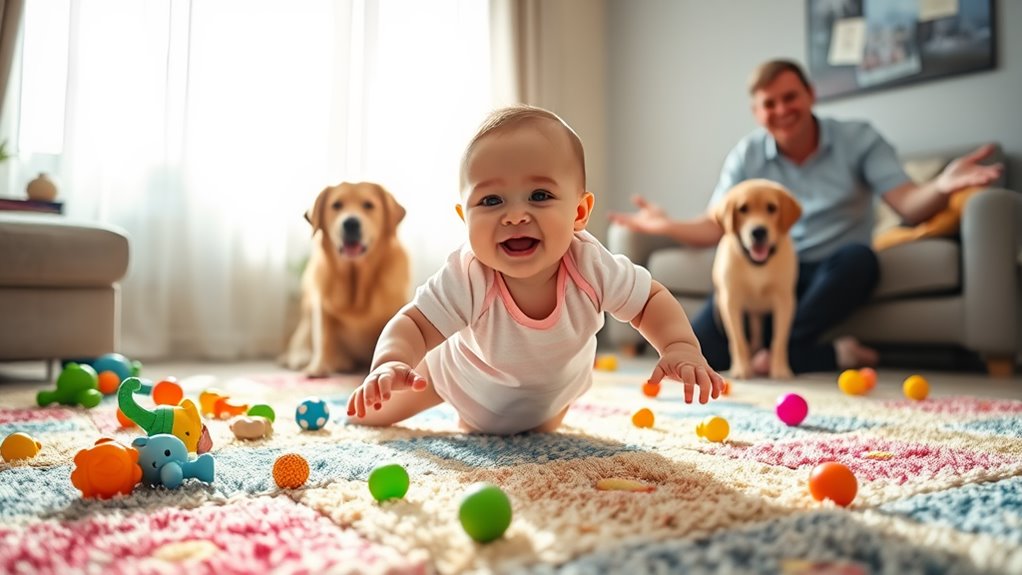You might be shocked to learn that most babies start crawling between 7-10 months and often walk soon after. When your little one pulls up to stand or cruises around furniture, they're on their way to mobility. It's an exciting time filled with both joy and anxiety for parents. To learn more about encouraging these milestones and ensuring safety during this adventurous phase, stick around and discover all the essential tips you need!
Key Takeaways
- Babies typically start crawling between 7-10 months, showing readiness through independent sitting and pushing onto hands and knees.
- Crawling styles vary, including classic crawling, army crawling, and bottom scooting, reflecting different developmental approaches.
- Walking milestones include pulling up to stand, cruising around furniture, and standing independently, usually developing around 9-15 months.
- Tummy time is crucial for developing the motor skills necessary for both crawling and walking.
- Emotional growth plays a significant role, influencing a child's confidence and curiosity in exploring their environment.
Understanding Crawling Milestones
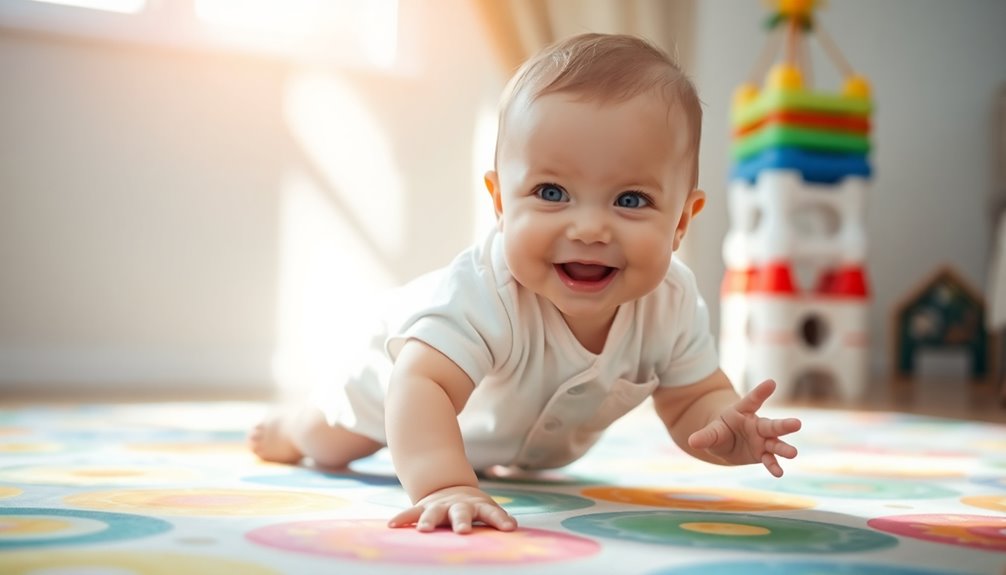
Crawling is an exciting milestone in your baby's development, usually starting between 7 and 10 months. You might notice signs of readiness like sitting up independently, pushing up onto hands and knees, or pivoting while on their tummy.
Tummy time plays a vital role in strengthening the motor skills necessary for crawling, so make sure to encourage it with toys placed on elevated surfaces. As babies gain mobility, their sleep patterns may shift, often leading to challenges around 8 or 9 months.
Keep in mind that there are various crawling styles, including classic crawling, army crawling, and bottom scooting, showcasing each baby's unique development. Emotional and psychological growth is an important aspect of this stage, as it influences their confidence and exploration.
Different babies crawl in their own unique ways—classic crawling, army crawling, or bottom scooting—each reflecting their individual development journey.
Celebrate these milestones as they pave the way for even more exciting adventures!
Signs Your Baby Is Ready to Walk
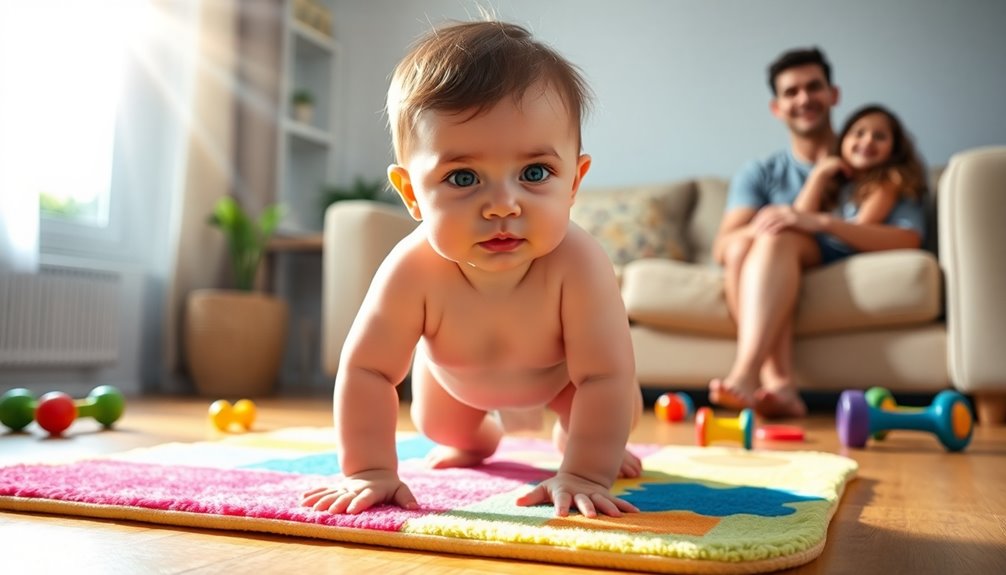
As your baby approaches the walking stage, you'll notice several key signs that indicate readiness.
Look for these signs of your baby's growing independence:
- Pulling up to stand, strengthening leg muscles and coordination.
- Increased confidence and curiosity to explore new environments.
- Cruising around furniture, honing balance and weight-shifting skills.
- Walking with assistance, using push-toys or holding your hands, promoting speed.
- The ability to stand independently, even for a few seconds, shows improved balance and stability.
These motor milestones suggest that your baby is ready to take those first steps.
Incorporating early socialization and training into your baby's routine can further enhance their confidence as they begin to walk.
Pay attention to these signs, and prepare for an exciting journey into walking!
How to Encourage Your Baby to Crawl
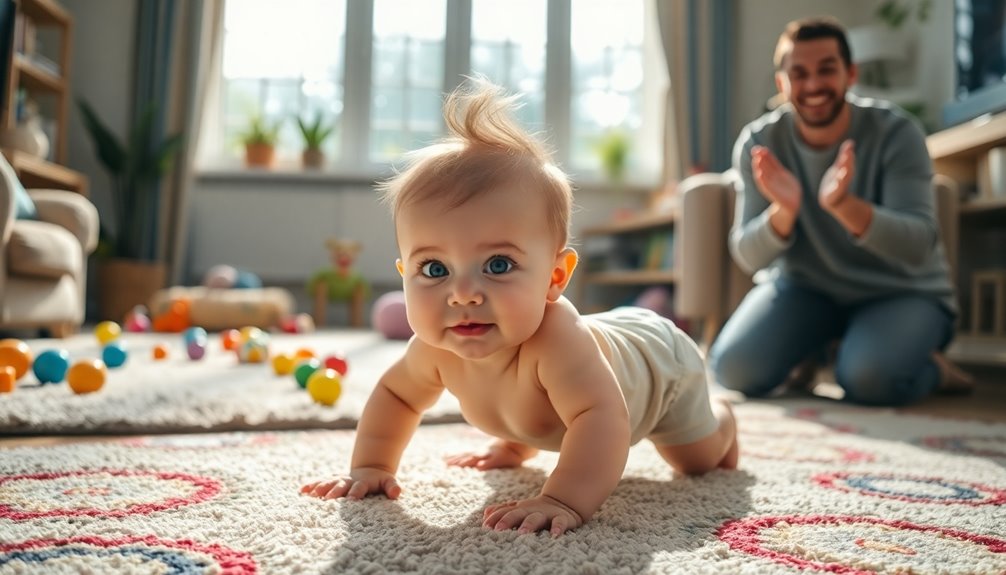
While your baby may be enthusiastic to explore the world around them, encouraging crawling can help them develop essential motor skills.
Start by engaging in regular tummy time sessions for 15-30 minutes, which strengthens the muscles needed for crawling. Place toys just out of reach to motivate your baby to move around and reach for them, fostering crawling behavior.
Engage in 15-30 minutes of tummy time to strengthen your baby's muscles and encourage crawling through playful reach.
Additionally, using elevated surfaces for toys can encourage your baby to push up, enhancing their arm and core strength. Avoid slippery clothing to improve traction on various surfaces.
Finally, practicing gentle push-ups together can inspire your baby to mimic movements, boosting their coordination and overall baby development. Incorporating tummy time into your routine will significantly support their crawling journey.
These techniques will help encourage your baby's crawling journey!
The Emotional Journey of Early Walking
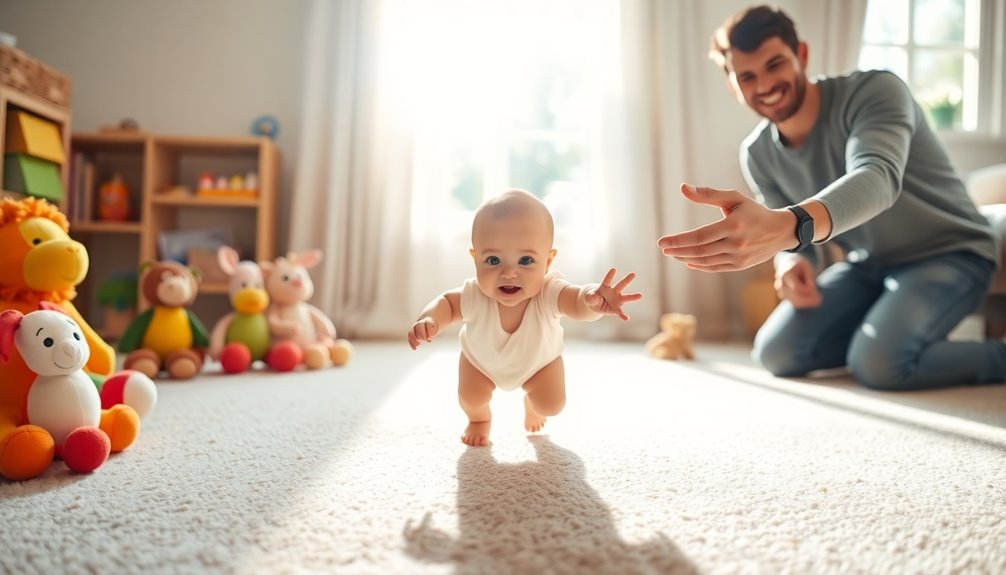
Watching your baby take those first wobbly steps can stir a whirlwind of emotions. You might feel a mix of joy and nostalgia, realizing your little one is growing up too fast.
Early walking comes with its own emotional impact, especially when others comment on your child's milestones. Here are a few feelings you might experience:
- Overwhelming parental pride in your child's adventurous spirit
- Anxiety about their curious nature and the need for increased supervision
- Nostalgia for the baby stage as they become more independent
- Pressure from development comparisons with other children
- The joy of witnessing significant milestones while adapting safety measures
Additionally, it's important to remember that early walking can also be linked to increased physical activity, which is beneficial for overall health. Embrace this journey; it's a beautiful yet challenging change for both you and your child.
Safety Tips for Early Movers

When your little one starts moving around, ensuring their safety becomes a top priority. Follow these safety tips to protect your early walkers.
Begin with babyproofing your home—secure stable furniture to prevent falls and remove choking hazards like small objects. Supervision is essential; keep a close eye during outings, as their adventurous nature can lead to quick wanderings.
Create safe play areas using crawling mats and soft surfaces to cushion falls while they explore. Establish clear, safe paths for cruising by arranging stable furniture, allowing your baby to practice walking skills without accidents. Additionally, consider implementing safety precautions to avoid hazards during installation of home features like wood stoves.
Frequently Asked Questions
What Happens if a Baby Skips Crawling and Goes Straight to Walking?
If your baby skips crawling and goes straight to walking, don't worry too much.
Many infants take different paths in their development, and it's perfectly normal. Babies may use other movements, like scooting or rolling, which still promote strength.
As long as your little one is achieving other motor skills, like pulling up to stand, there's typically no cause for concern.
Just keep an eye on their overall development; every child is unique.
How Soon After Crawling Do Babies Walk?
Like a butterfly emerging from its cocoon, your baby's journey from crawling to walking unfolds uniquely.
Generally, you'll see your little one take their first steps about a month after they start crawling. However, some might take a bit longer, while others leap into walking almost immediately.
This progression is a beautiful dance of confidence and exploration, with each child finding their rhythm at their own pace, so enjoy every moment of this excitement!
Does an Early Walker Mean Anything?
An early walker can indicate certain cognitive advantages, like improved memory and attention skills later in life. However, it's not a guarantee of overall intelligence or coordination.
While some studies link early walking to better language development through increased interactions, results vary.
It's important to remember that premature walking might also pose health risks, so if you're concerned about your child's progress, consulting a healthcare provider is a smart move.
How Long Do Babies Scoot Before They Crawl?
Babies typically scoot for several weeks before they start crawling, often around 6 to 8 months old.
Some might scoot for just a few days, while others could continue this phase for a month or more. It varies from child to child.
You can encourage this shift by engaging in tummy time and placing toys on elevated surfaces, which helps strengthen their muscles and coordination for the next stage of movement.
Conclusion
In the journey of your baby's development, crawling and walking are like the first steps of a grand adventure. As they explore their newfound mobility, it's crucial to celebrate each milestone while keeping safety in mind. Encourage their curiosity and independence, and remember, every wobble and stumble is just part of the dance of growth. So, embrace this exciting phase and watch your little explorer flourish, one tiny step at a time!
